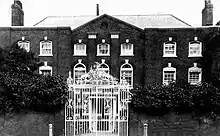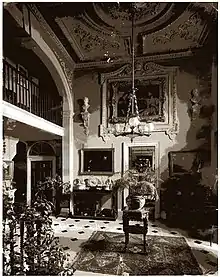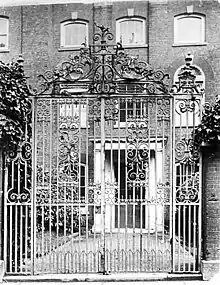
Burleigh House was a house in Enfield, near London, that was built in the mid-17th century for the lawyer James Mayoe. It was constructed on the grounds of a house once owned by the merchant Benjamin Deicrowe Jr. that Mayoe obtained from the indebted Deicrowe through legal manoeuvring. Burleigh House, which did not receive that name until the 19th-century, was particularly known for its ornate iron gates. It was demolished in 1913 and shops and a cinema built on its grounds but is remembered in the modern Burleigh Way.

History
Burleigh House was built in Church Street, west of Enfield Marketplace,[3] in the mid-17th century for the lawyer James Mayoe, who erected it on the site of a larger house once owned by the merchant Benjamin Deicrowe Jr., which, through connivance and legal manoeuvring, Mayoe had obtained from the indebted Deicrowe.[4]
James Mayoe passed the house to Clement Mayoe, who left it to his friend Robert Fish, who owned it in 1697.[2] The house was named Burleigh House by the stockbroker Joseph Withers who was tenant there with his family from 1865.[1] Joseph died in 1888[5] but his wife Emma continued to live at the house until her death in 1907.[6]
The house was said to have a ghost dressed in doublet, hose and ruffle.[7]
Architecture

The central part of the house, and probably the oldest, was ornamented by brick pilasters. The entrance hall was of Purbeck stone with a fireplace decorated with Flemish tiles. In the early 1900s, the kitchen still had a roasting spit that was thought to be 200 years old and a deep well that still provided water. The drawing room was on the first floor with three round-headed windows and a chimney-piece in white marble showing Alexander the Great. Above the drawing room were the bedrooms. One room contained a fireplace with the initials BDM for Benjamin and Margaret Deicrowe.[7] A noted feature of the house was its iron gates, believed to have been made by the blacksmith Thomas Warren (1673-1736).[9]
Demolition and legacy
The house was demolished in 1913 with the fixtures and fittings sold at auction and the site sold for £7,000.[7] Shops were built on the frontage by 1914[7] and the Rialto Cinema built on the bulk of the site in 1920. The cinema was renamed the Granada in 1967 and closed in 1971. The building then became a bingo hall before it was replaced by housing.[1][3]
The house is remembered in Burleigh Way, north of Church Street and to the west of the marketplace.[10] Sale catalogues and correspondence relating to the sale of the house are held by the London Metropolitan Archives.[11]
See also
Notes and references
- 1 2 3 "Enfield Town 1870-1914" by Stephen Gilburt in Enfield Society News, No. 216 (Winter 2019), p. 7.
- 1 2 Pam, David. (1990) A History of Enfield Volume One - Before 1837: A Parish Near London. Enfield: Enfield Preservation Society. pp. 168-171. ISBN 0907318096
- 1 2 "Enfield: Growth before 1850". British History Online. Archived from the original on 1 December 2015. Retrieved 17 November 2019.
- ↑ A detailed account of the legal proceedings through which Mayoe obtained the house from Deicrowe may be found in Pam's History of Enfield, Vol. 1, pp. 168-170.
- ↑ 1888 Probate Calendar. p. 318.
- ↑ 1907 Probate Calendar, p. 242.
- 1 2 3 4 Pam, David. (1992) A History of Enfield Volume Two - 1837 to 1914: A Victorian Suburb. Enfield: Enfield Preservation Society. p. 86. ISBN 090731810X
- ↑ Burleigh House and gates, Church Street. The Enfield Society. Retrieved 18 November 2019.
- ↑ Gardner, J. Starkie. (2017). English Ironwork of the XVIIth and XVIIIth Centuries - An Historical and Analytical Account of the Development of Exterior Smithcraft. Read Books. p. 27. ISBN 978-1-4733-4018-3.
- ↑ Burleigh Way, Enfield. Open Street Map. Retrieved 18 November 2019.
- ↑ Burleigh House Estate, Enfield Town. AIM25. Retrieved 18 November 2019.
External links
![]() Media related to Burleigh House, Enfield at Wikimedia Commons
Media related to Burleigh House, Enfield at Wikimedia Commons